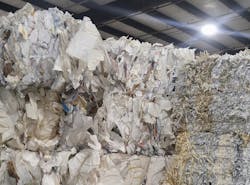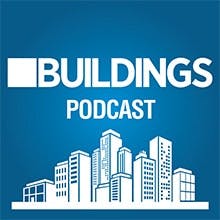The Many Benefits of Industrial Recycling Programs
What happens to your recyclables after they leave your facility? Depending on what you’re throwing out, your trash may be turned into toilet paper, cardboard shipping boxes, insulation and more.
BUILDINGS toured the Marion, Iowa location of Quincy, Illinois-headquartered Quincy Recycle with Alan Schumacher, business development and sales for Quincy and president of the Iowa Recycling Association, to see how industrial recycling turns waste into reusable material.
Reasons to Recycle
There are many reasons to set up an organized industrial recycling program or beef up your existing one, Schumacher says.
Aside from the obvious boost to your green credibility, recycling building materials and office refuse can:
- Help you earn credits toward a building certification
- Reduce your landfill fees
- Earn a profit from selling your processed recycled material
“I like to say we’re hunters and gatherers of like material,” Schumacher explains. “We take the material that a lot of people throw their hands up about and say ‘I don’t know what to do with it’ and try to find them resources. We try to focus on finding the best solution for each vendor’s need and try to provide them with a return if at all possible.”
Where Your Industrial Recycling Goes
You can ship industrial recycling material to your recycling partner in a number of ways, Schumacher says. Your waste hauler might gather your material in a compactor or pack it into 4-foot by 4-foot gaylord boxes.
“There’s still value in doing what we’re doing, and in the long term we should not ever quit recycling because it’s the right thing to do.” - Alan Schumacher
Paper products might be baled together or delivered loose to the recycler. Then the recycler will process your recyclables and sell the resulting raw materials to a business partner, who will turn them into new products.
“Sorted office paper, a really good white grade, we’ll send to a mill and they’ll make toilet paper, tissue and paper towels out of it,” says Schumacher.
“We gather a lot of No. 8 and No. 9 newspaper and forward that to insulators who shred it, add cellulose and fire retardant back to it, and sell it to retailers. We do a lot of cardboard here that becomes new corrugate. We also have markets for PET plastic, HDPE plastics, LDPE shrink film and other plastics,” he continues.
Improve Your Industrial Recycling Program
Start by assessing your current practices and the different waste products your facility generates. Schumacher suggests asking yourself these four questions:
1. What are your pain points?
Is something missing in your current recycling program? Do you need to gain more value from the materials you’re returning, or is it more of a service issue with your current provider?
2. How much waste material do you generate?
Project the volume of your various waste materials to help your recycler determine how best to serve you, Schumacher says.
“What are you getting for your materials now? Why are you baling or not baling? How are you measuring this? Are you getting paid for your material?” asks Schumacher.
“I want to know by volume and grade of material what they’re doing now so I can see if the account has value not only for Quincy Recycle, but for themselves to enhance what they’re doing. Can I make a difference? Can I make a change in what they’re doing, either in value or process?” he states.
3. How urgent is your need?
Work with your recycler to develop a timeframe for them to do a site visit. The recycler will examine your waste and recycling processes on-site and review your disposal and profit options.
“I still like to do the good old-fashioned dumpster dive. We look at what’s going on and ask how many times a month does this load get pulled to the landfill, what’s your pull charge, what’s your compactor rental and what’s your landfill charge,” explains Schumacher.
[More on sustainability: Zero Waste Tips for Event Venues]
“If we feel that you have 40-percent volume of good material in that compactor and it’s 10,000 pounds a month going to the landfill, then that’s 4,000 pounds that you could be keeping out of the landfill, which would almost reduce your pull charges and landfill expense by 40 percent,” he says.
You may have some one-time recycling jobs, like a PVC roofing membrane that you’re replacing during a reroofing project.
Good recyclers will still recycle it for you, but there may be an extra cost associated with the small load, Schumacher explains.
(Pictured: Alan Schumacher, business development and sales for Quincy and president of the Iowa Recycling Association)
“The charge might be because they have 10,000 pounds of material, but a mill typically has 40,000 pounds and the freight involved with it costs three times as much if you don’t have a full load. It may cost a little more, but we can still keep it out of the landfill.”
[On topic: Plastic Stays Out of Ocean With Second Life]
Financial profits associated with recycling are lower now that China no longer accepts recycling commodities from the U.S., Schumacher notes. However, the other benefits of repurposing usable material are undeniable.
Showing off your use of reclaimed materials is more than a contribution toward your green building certification – it’s a statement that your organization cares about the environment.
[podcast]
“There’s still value in doing what we’re doing, and in the long term we should not ever quit recycling because it’s the right thing to do,” Schumacher explains. “Change is coming. People are starting recycling processes domestically. I’m seeing it now where people are opening businesses to start recycling plastic materials here in the Midwest vs. exporting it. It’s coming. Stay tuned.”
Two handpicked articles to read next:
About the Author
Janelle Penny
Editor-in-Chief at BUILDINGS
Janelle Penny has been with BUILDINGS since 2010. She is a two-time FOLIO: Eddie award winner who aims to deliver practical, actionable content for building owners and facilities professionals.


